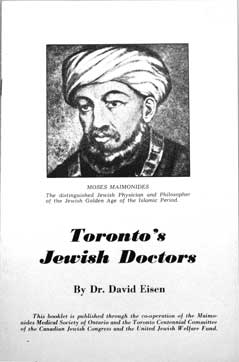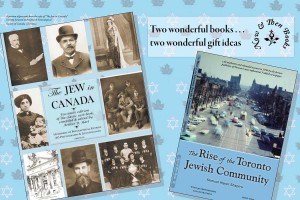 Dr. David Eisen, Toronto’s first Jewish radiologist, was always intrigued with Jewish history. The youngest son of a Galician peddler who came to Toronto about 1902, David Eisen attended the University of Toronto’s medical school from 1917 to 1922, and joined the Mount Sinai Hospital after graduating.
Dr. David Eisen, Toronto’s first Jewish radiologist, was always intrigued with Jewish history. The youngest son of a Galician peddler who came to Toronto about 1902, David Eisen attended the University of Toronto’s medical school from 1917 to 1922, and joined the Mount Sinai Hospital after graduating.
A quarter of a century ago, Eisen published a diary of his medical school years. Although he died in 1987 at the age of 87, his Diary of a Medical Student stands as a modest contribution to the subject of Toronto’s Jewish history.
Despite his rigorous medical studies, Eisen was involved with various Judaic organizations, such as the Toronto Hebrew Students Association, the Menorah Society and the Zionist Institute. He records that the city seemed unwilling or unable to accommodate to the growing number of Jews in its midst. “Yom Kippur today,” he records on September 26, 1917. “Lectures started but I did not attend. I spent the morning in the recently founded synagogue across the street….”
Perhaps the most interesting entries in Eisen’s diary recall the flu epidemic that claimed 58 people in one day, the firecrackers and bonfires on downtown streets upon news of the Armistice, and the Jewish life, glimpsed in passing but telling detail.
December 10, 1917: “The British capture of Jerusalem was announced today. I certainly felt a thrill when I heard about it. I was retrieving my hat and coat from the cloak-room attendant at the Reference Library and noticed the large headlines in the newspaper that he was reading. When I reached Spadina Avenue, I bought all three evening papers….”
November 18, 1918: “Today I noticed in the Star Weekly an article in the form of a review of a book written by a Dr. Rihbany, a Syrian, who pleads the Arab cause and asks America ‘to save the Near East’ from the rapacious Zionists. Quite a few misleading statements were made by the reviewer, presumably on the basis of what appeared in the book. I wrote a letter to the Star criticizing the review.”
In 1957 Eisen published an interesting treatise on Toronto’s Jewish doctors, later reprinted as a booklet with a portrait of Moses Maimonides on the cover. Toronto’s first Jewish doctor, Samuel Lavine (1875-1959), made his early rounds on a bicycle, but later changed to the “more fashionable, but less dependable, automobile,” he noted.
In 1965, Eisen became the chief archivist for the Holy Blossom Temple, whose bulletin often carried delightful little historical pearls from him. He wrote about the city’s early Jewish settlers, pioneers in the clothing industry, Toronto’s first synagogue, the Richmond Street synagogue, and how the Holy Blossom acquired its unusual name.
An habitue of archives and libraries, he discovered a picture of Toronto’s first synagogue and made a comprehensive study of burials in the 150-year-old Pape Avenue cemetery. He wrote about Rabbi Elzas, an early rabbi, and received an informative letter from Elzas’s elderly daughter in New York. In a column on Arthur Wellington Hart, the first Jew known to live here (from about 1833), he wrote: “Those of our co-religionists who are insurance agents can now hold their occupational heads high in the knowledge that theirs is the oldest Jewish business in Toronto!”
Eisen’s diary throws little light on his years at Mount Sinai, which had only 35 beds when he started working there alongside L.J. Solway, A.I. Willinsky, L.J. Breslin and other pioneering Jewish medics. Eisen was not among this first wave of Jewish doctors — but he managed to make his mark on local Jewish history, all the same. ♦
© 2002







